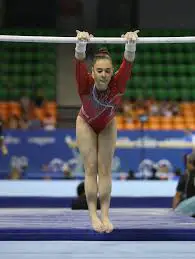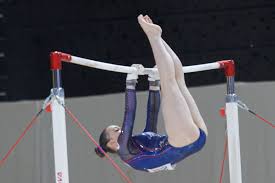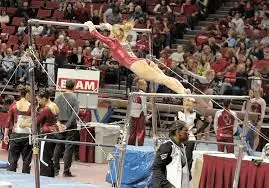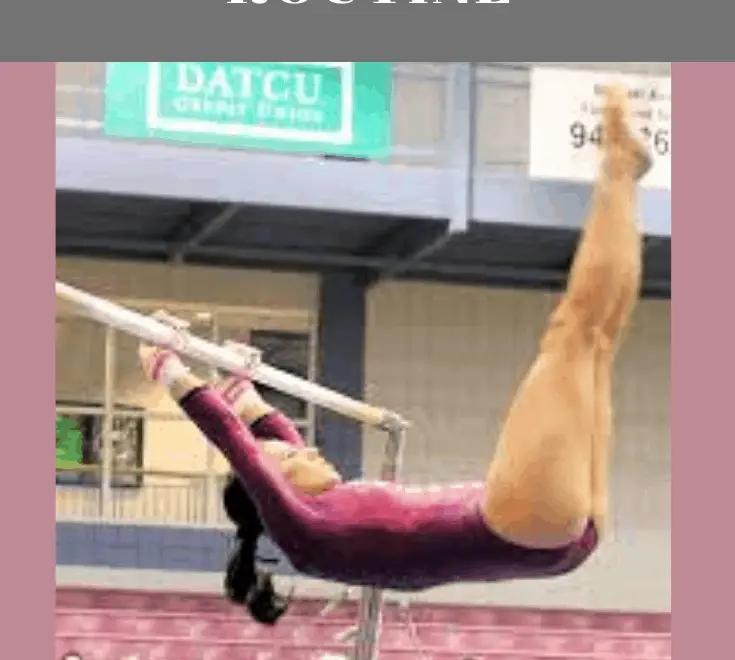This post has been updated to reflect changes to the 2021 compulsory routines.
The Level 4 bar routine comes with some big changes, compared to Level 3. Kips! Jumping to the high bar! These new, big skills can present quite a challenge to a new Level 4 gymnast.
When I first competed at this level, I was terrible at bars. I would fall on my kips almost all of the time. My scores were awful. I thought that staying on the bars was the only thing I needed to do in order to bring my scores up. But it turns out there were lots of little things I could have done to make a difference in my scores.
What are some of these little things? Let’s take a look at some of the small (and large!) errors that commonly occur during a Level 4 bar routine. If you’d like to know more about Level 2, Level 3 or Level 5 bars, click the links for articles about those routines!
Sometimes, when gymnasts start to work on the high bar, the coach will want them to wear grips. Check out the Guide to Gymnastics Grips to help you choose the perfect pair!
How a Level 4 Bar Routine is Evaluated
Each skill in the Level 4 bar routine has specific deductions that can be taken on that skill. These deductions relate to the technique that is expected for the skill. In addition to these deductions, there are general execution deductions that can be applied. We’ll talk more about those in a minute. Finally, a judge can take general routine deductions, which are deductions for the overall impression of the routine. If you’re curious about that, here’s an article that discusses general deductions in detail.
General Execution Deductions
General execution deductions are deductions that can be taken on any major element (skill) in a routine. Here is a list of general execution deductions that could occur during a Level 4 bar routine:
- Foot form – 0.05
- Leg separation – Up to 0.20
- Body alignment/position/posture in major elements – Up to 0.20
- Bent arms or legs (max deduction at 90 bend) – Up to 0.30
- Balance errors – Up to 0.30
- Fall (on or off the apparatus) – 0.50
- Repositioning of hands in support or feet in squat on – 0.10
- Alternate hand grasp – 0.20
- Extra cast or swing – 0.30 (maximum 0.50 if >1)
- Supplementary support to regain position – 0.30
- Brush/touch on apparatus or mat with foot or feet – Up to 0.10
- Hit on apparatus with foot – 0.20
- Hit on mat with feet – 0.30
- Full weight on mat with feet – 0.50
You can see that larger errors result in larger deductions. It’s more costly to fall off the apparatus than to forget to point your toes. However, small errors repeated over several skills can also add up. For instance, a gymnast might have a small knee bend and a body position error (0.10 each) on every skill in her routine. After making these errors on all 9 skills in the routine, she has just lost 1.8 in deductions!
On bars, using good technique and body position will minimize many deductions. Don’t sacrifice technique to meet the amplitude requirements. The first suggestion I would give anyone looking to improve their score is to look at a video of your routine. Next, try to clean up little knee bends, arm bends, and foot form errors. This can make a big difference in your final score! Using the example of my routine, I often bent my knees during my skills, finished skills with bent arms, and had rhythm errors between skills. If I had realized it, I could have cleaned all of that up!
Looking for a practice bar for home? Check out the Guide to Home Gymnastics Equipment for some recommendations!
Level 4 Bar Routine Skills
Now, let’s look at some specific deductions for each skill in the Level 4 bar routine.

Mount: Glide kip
The glide kip in Level 4 has the same deductions as in Levels 3 and 5. The gymnast should jump off both feet into the glide swing, or she could receive a 0.10 deduction. If she performs a run-out glide, it is a 0.30 deduction. The feet should lead and stay in front of the body during the glide (up to 0.10 deduction). Her body should extend completely at the end of the swing, or she can lose up to 0.20 for lack of extension in the glide. If the gymnast fails to close her legs at the end of a straddle glide, it is a 0.10 deduction.
Other common deductions in a glide kip are bent legs in the glide (up to 0.30), bent arms (up to 0.30), poor body position (up to 0.20) and rhythm errors moving into the cast. Also, if the gymnast has to stop and pump her legs to initiate the cast, she will receive a 0.30 deduction for an extra swing.
Cast horizontal and return
Level 4 is the first level in which gymnasts have amplitude requirements for the cast. Cast angles are determined by making an imaginary line between the shoulders and the lowest body part. This means that if the gymnast has an arched body, the line would be drawn between her shoulders and her belly. If she is piked, the line would be between her shoulders and feet. If she casts with a straight body, the line would go straight down the length of her body.
The amplitude deductions for the cast vary depending on how close the cast is to horizontal. At or above horizontal, there is no amplitude deduction. If the angle is between 1°-45° below horizontal, the deduction is 0.05-0.15. If the cast angle is 46° or more below horizontal, the deduction is 0.20-0.30. Remember, if a gymnast also has a body position error, she will receive deductions for the error, AND the amplitude.
The cast should be performed with straight body alignment from the shoulders to the feet, and a hollow position in the chest. Other specific deductions for the cast include poor body alignment (up to 0.20) and lack of control in returning to the bar (up to 0.10). Often, a deduction for bent arms is applied because the gymnast initiates or finishes the cast with bent arms.
Cast, squat/pike on OR Cast, backward sole circle
The gymnast can perform a squat on, a pike on, or a backward sole circle with no penalty.
If the gymnast performs the sole circle, she has three options for the entry: squat on, pike on, or late drop. If she chooses the late drop technique, it is acceptable to use a step-in
The deductions are the same for all three options: 0.20 for alternate foot placement, and 0.05 for insufficient leg swing into the squat/pike on (taken if the gymnast lifts her hips only). Other common deductions include leg/foot separation (up to 0.20) and steps or repositioning of feet on the bar as the gymnast prepares for her jump to high bar (0.10).

Jump to long hang kip
The jump to long hang kip starts with a good, tight body jump to the high bar. Many gymnasts, especially if the jump is scary to them, will jump with bent knees (up to 0.30) and legs separated (up to 0.20). If the arms bend when the gymnast catches the bar, she could incur a deduction of up to 0.30.
The only specific execution deduction for the long hang kip is failure to swing to near horizontal (up to 0.20). General deductions will apply to the kip, and if the gymnast stops and pumps her legs before the cast, she will receive a 0.30 extra swing deduction.
Cast horizontal
These deductions are exactly the same as the low bar cast, and are applied the same. The gymnast must still cast immediately out of the kip, and amplitude deductions are applied based on the same line from the shoulders to the lowest body part.
Back hip circle
Next, the gymnast should move immediately into the back hip circle. If she does not continuously circle around the bar, she could receive a deduction of up to 0.10. She should maintain a straight-hollow body position (up to 0.20) and a neutral head (up to 0.10) throughout the back hip circle. The hips or upper thighs should remain in contact with the bar throughout the circle (up to 0.20). General deductions such as bent arms or leg separations can also be taken during the back hip circle.
Underswing, 1st counterswing (30° below horizontal)
The underswing should be performed by keeping the bar at the thighs, and opening the shoulders as the hips rise. If the hips touch the bar during the underswing, it is a 0.20 deduction. There is no deduction for the thighs touching the bar. The head should stay neutral (up to 0.10) and the body position should still be straight-hollow (up to 0.20 if it is not).
As the gymnast swings back into the counterswing, the hips are expected to reach a minimum of 30° below horizontal. If the hips are lower than this, a deduction of up to 0.20 can be applied. The body should be in a straight line from the hands to the hips, the chest should be hollow, and the hip angle should be rounded. If this body shape does not occur, there could be a deduction of up to 0.20. It’s acceptable for the hips to pike in order for the feet to clear the low bar, but excessive piking could incur a deduction. If the body is arched over the low bar, or if the hips are open and extended with the feet over the low bar, a flat 0.30 deduction will be taken.
Tap swing, 2nd counterswing (30° below horizontal)
Next, the gymnast should perform a tap swing, showing a slight arch at the bottom of the swing to initiate the tap. A 0.10 deduction is taken if the gymnast does not show this slight arch. The gymnast should then return to the straight-hollow body position on the upswing. There is a deduction of up to 0.20 for poor body position. If the forward swing does not reach the height of the high bar, judges can apply an amplitude deduction of up to 0.20.
The second part of this skill is the second counterswing, which, like the first counterswing, is expected to reach 30° below horizontal. The deductions for the second counterswing are exactly the same as the first counterswing.
Dismount: Tap swing forward with 1/2 turn
First, the dismount should be initiated with a slight arch (tap) at the bottom of the swing, with a 0.10 deduction applied if the tap is missing. Next, the gymnast should return to the straight-hollow position on the upswing (up to 0.20 deduction). If the 1/2 turn begins prior to 45° below the high bar, a deduction of up to 0.20 can be taken. Finally, the 1/2 turn must be completed before the gymnast re-contacts the bar with her hand (up to 0.20 deduction). If the free hand never comes back into contact with the bar, a flat 0.30 deduction is taken. The gymnast does not have to grasp the bar with the free hand, but she does at least need to touch the bar.

Closing Thoughts
In summary, a great Level 4 bar routine will have excellent body position, good rhythm, and straight arms and legs. The amplitude of the skills is not as important as the body position, so keep working on that form! The skills in Level 4 build toward Level 5 and above. This means that doing them with good technique will serve you well in the future, plus it will help you get great scores at Level 4 bars.
What questions do you have about bars? Is there a particular skill or technique that trips you up? Drop a comment with your thoughts!
Further Reading
5 Tips for a Stellar Handspring Vault
How to Perform the Best Level 4 Beam Routine
The Ultimate Guide to Gymnastics Grips
How to Perfect Your Level 2 Bar Routine
How to Perfect Your Level 3 Bar Routine
How to Perfect Your Level 5 Bar Routine
General Categories for Exemplary Compulsories
Preview of 2021-2029 Compulsory Skills
The Best Gymnastics Grips You Need to Use
References
USA Gymnastics Compulsory Handbook, 2021-2029.
